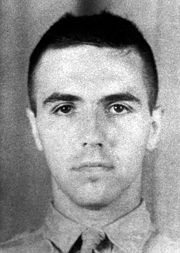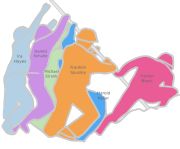| René Arthur Gagnon | |
|---|---|
 Rene Arthur Gagnon | |
| Born | March 7, 1925 |
| Died | October 12, 1979 (aged 54) |
| Place of birth | Manchester, New Hampshire |
| Place of death | Manchester, New Hampshire |
| Allegiance |
|
| Service/branch |
|
| Years of service | 1943–1946 |
| Rank |
|
| Unit |
2nd Battalion 28th Marines 5th Marine Division |
| Battles/wars | |
René Arthur Gagnon (March 7, 1925 – October 12, 1979) was one of the United States Marines immortalized by Joe Rosenthal's famous World War II photograph Raising the Flag on Iwo Jima.
Early life[]
Gagnon was born March 7, 1925 in Manchester, New Hampshire, the only child of French Canadian immigrants from Disraeli, Quebec, Henri Gagnon and Irène Marcotte. He grew up without a father. His parents separated when he was an infant, though they never divorced. When he was old enough, he worked alongside his mother at a local shoe factory. He also worked as a bicycle messenger boy for the local Western Union. He was drafted in 1943 and elected to join the Marine Corps.
World War II[]
On May 6, 1943, he was inducted into the Marine Corps Reserve and sent to Marine Corps Recruit Depot Parris Island, South Carolina. From Parris Island, Private First Class Gagnon, promoted on July 16, 1943, was transferred to the Marine Guard Company at Charleston Navy Yard in South Carolina. He remained there for eight months and then joined the Military Police Company of the 5th Marine Division at Camp Pendleton, California. Four days later, on April 8, 1944, he was transferred to Company E, 2nd Battalion, 28th Marine Regiment. In September, the 5th division left Camp Pendleton for further training at Camp Tarawa, Hawaii, for the assault on Iwo Jima code named Operation Detachment, by three Marine divisions of the V Amphibious Corps.

A diagram identifying all six men
On February 19, 1945, Gagnon landed with the 28th Marines on "Green Beach 1" on the southeast side closest to Mount Suribachi on the southern end of Iwo Jima. Four days later - though with much fighting still ahead - Gagnon, A Marine runner, participated in what was most likely the most celebrated flag raising in U.S. history. After the event, Gagnon recalled:
"On the morning of February 23 when the Colonel ordered these four men to take up the flag, they started going up and the communications were faulty between the top and the bottom of the mountain and they ordered me to take up the radio battery. When I got up there the four-man patrol with the flag had just got up there and they were about ready to put it up and when I got up I delivered the battery and then I went over to them and I was watching them put up the flag and the very heavy Japanese pipe…it weighed quite a lot…so they said lend a hand…so I just got into it. [...]"
According to former Marine Lt. George Greeley Wells, he was the battalion adjutant in charge of carrying the American flag for the battalion, and that he had Gagnon, a company runner, get the second American flag for him from a ship on shore (possibly the USS Duval County[1][1][2]) that was taken up Mount Suribachi by Gagnon to Lt. Schrier with a message for Lt. Schrier to raise the flag and give the first flag to Gagnon to take back to him. Wells claims he had handed the first flag to Lt. Schrier to take up Mount Suribachi and later Gagnon reported back to him with the first flag from Lt. Schrier which he, Wells, then secured until it was given to Marine Headquarters after the battalion returned to Hawaii from Iwo Jima.[3]
A third American flag was officially raised by two Marines at Marine Headquarters located at the base of Mount Suribachi on March 14, 1945. At the same time this flag was raised, the second flag on top of Mount Suribachi was lowered, and taken to Marine headquarters.
When the 28th Marines left Iwo Jima for Hawaii, Gagnon, aboard the transport USS Winged Arrow (AP-170)[4] with Ira Hayes, was the first to be identified as one of the six-flag raisers in the photo and was ordered to Washington, D.C., arriving on April 7. Together with the other two identified survivors of the second flag raising, Navy Pharmacist's Mate John Bradley and Marine Private First Class Ira Hayes, he was assigned to temporary duty with the Finance Division, U.S. Treasury Department, for appearances and participation in connection with the Seventh War Loan drive (bond selling tour) in May and June 1945. The tour was through several major U.S cities raising billions of desperately needed dollars and moral at home to help win the war.[5][6] The three flag-raisiers had the second American flag with them during the bond tour.
In July 1945, he was ordered to San Diego for further transfer overseas. Gagnon married Pauline Georgette Harnois, of Hooksett, New Hampshire, in Baltimore, Maryland, on July 7, 1945. By September, he was on his way overseas again, this time with the 80th Replacement Draft. On November 7, 1945, he arrived at Tsingtao, China, where he joined Company E, 2nd Battalion, 29th Marines, 6th Marine Division. He later served with the 3rd Battalion of the same regiment. On duty with the U.S. occupation forces in China for nearly five months, Gagnon boarded a ship at Tsingtao at the end of March 1946 that was bound for San Diego.
He arrived in San Diego on April 20. With nine days short of three years' service in the Marine Corps Reserve, of which 14 months was spent overseas, Gagnon was promoted to Corporal. Gagnon was honorably discharged at Camp Pendleton, California, on April 27, 1946.
Military awards[]

CPL Gagnon's service ribbons at the time of his discharge from the Marines.
- Combat Action Ribbon[7]
- Presidential Unit Citation with silver 5/16 inch star
- China Service Medal
- American Campaign Medal,
- Asiatic-Pacific Campaign Medal with bronze service star
- World War II Victory Medal
Post-war[]
He appeared in two films about the battle: To the Shores of Iwo Jima (a government documentary which simply showed the color footage of the U.S. flag raising) and Sands of Iwo Jima (1949), the latter with fellow surviving flag raisers Bradley and Hayes. He was also part of a Rose Bowl half-time show. However, in the end, it amounted to almost nothing, and left him bitter and an alcoholic. He worked at menial jobs, but was fired from most of them, the last one on Memorial Day, 1978.[citation needed] He died in October the next year at age 54, of a heart attack. In his last job, he had worked as a janitor at an apartment complex in Manchester.[citation needed] As recorded in the book Flags of Our Fathers, in his latter years Gagnon only participated in events that were at his wife's urging, events praising the U.S. flag raising on Iwo Jima. She enjoyed the limelight, whereas he, by that time, no longer did.
| “ | At the age of 53, he bitterly inventoried his lost 'connections' - the jobs promised him by the government people when he'd been at the height of his fame, jobs that never materialized. "I'm pretty well known in Manchester," he told a reporter. "When someone who doesn't know me is introduced to me, they say 'That was you in The Photograph?' What the hell are you doing working here? If I were you, I'd have a good job and lots of money.'" | ” |
- Death
Rene Gagnon died on October 12, 1979 in Manchester, New Hampshire leaving his wife Pauline Gagnon(Jan 16, 1926-Jan 16, 2006) and son Rene Gagnon Jr. He was buried at Mount Calvary Mausoleum. At the request of his widow, his remains were re-interred in Section 51, Grave 543 of Arlington National Cemetery on July 7, 1981. Gagnon is also memorialized in a special room at the Wright Museum of WWII History in Wolfeboro, New Hampshire.[9]
Portrayal in film[]
- Sands of Iwo Jima (1949), Gagnon played himself, raising the flag in the movie with Bradley and Hayes.
- The Outsider (1961), Gagnon was played by Ray Daley.
- Flags of Our Fathers (2006), Gagnon was played by Jesse Bradford
See also[]
- Battle of Iwo Jima
- Marine Corps War Memorial (sometimes referred to as the Iwo Jima Memorial)
- Flags of Our Fathers: James Bradley, 2000
- Meliton Kantaria - Soviet flag raiser over the Reichstag building in Berlin, 1945
- Mikhail Yegorov - Soviet flag raiser over the Reichstag building in Berlin, 1945
References[]
This article incorporates public domain material from websites or documents of the United States Marine Corps.
- ↑ http://www.navsource.org/archives/10/16/160758.htm
- ↑ http://www.uscg.mil/history/webcutters/LST_758.pdf
- ↑ The Man Who Carried the Flag on Iwo Jima, by G. Greeley Wells. New York Time, October 17, 1991, p. A 26
- ↑ http://navsource.org/archives/09/22/22170.htm
- ↑ The Mighty Seventh War Loan: http://www.bucknell.edu/x36352.xml
- ↑ "Video: Funeral Pyres of Nazidom, 1945/05/10 (1945)". Universal Newsreels. May 10, 1945. http://www.archive.org/details/1945-05-10_Funeral_Pyres_of_Nazidom. Retrieved February 20, 2012.
- ↑ Combat Action Ribbon (1969), retroactive from December 7, 1941: Public Law 106-65--Oct. 5, 1999, 113 Stat. 588, G
- ↑ Bradley, James and Ron Powers. Flags of Our Fathers, 2000. ISBN 0-553-11133-7
- ↑ Rene Gagnon, he was Canadian http://forums.canadiancontent.net/lounge/51882-rene-gagnon-he-canadian.html
- Corporal Rene Arthur Gagnon, USMCR, Who's Who in Marine Corps History, United States Marine Corps.
- Rene Arthur Gagnon, Corporal, United States Marine Corps, Arlington National Cemetery page.
External links[]
| Wikimedia Commons has media related to Rene Gagnon. |
- Rene Gagnon, Famous NH People
- The Flag Raisers on Iwojima.com
- Rene A. Gagnon at the Internet Movie Database
- Rene Gagnon's genealogy on rootsweb.com
The original article can be found at Rene Gagnon and the edit history here.